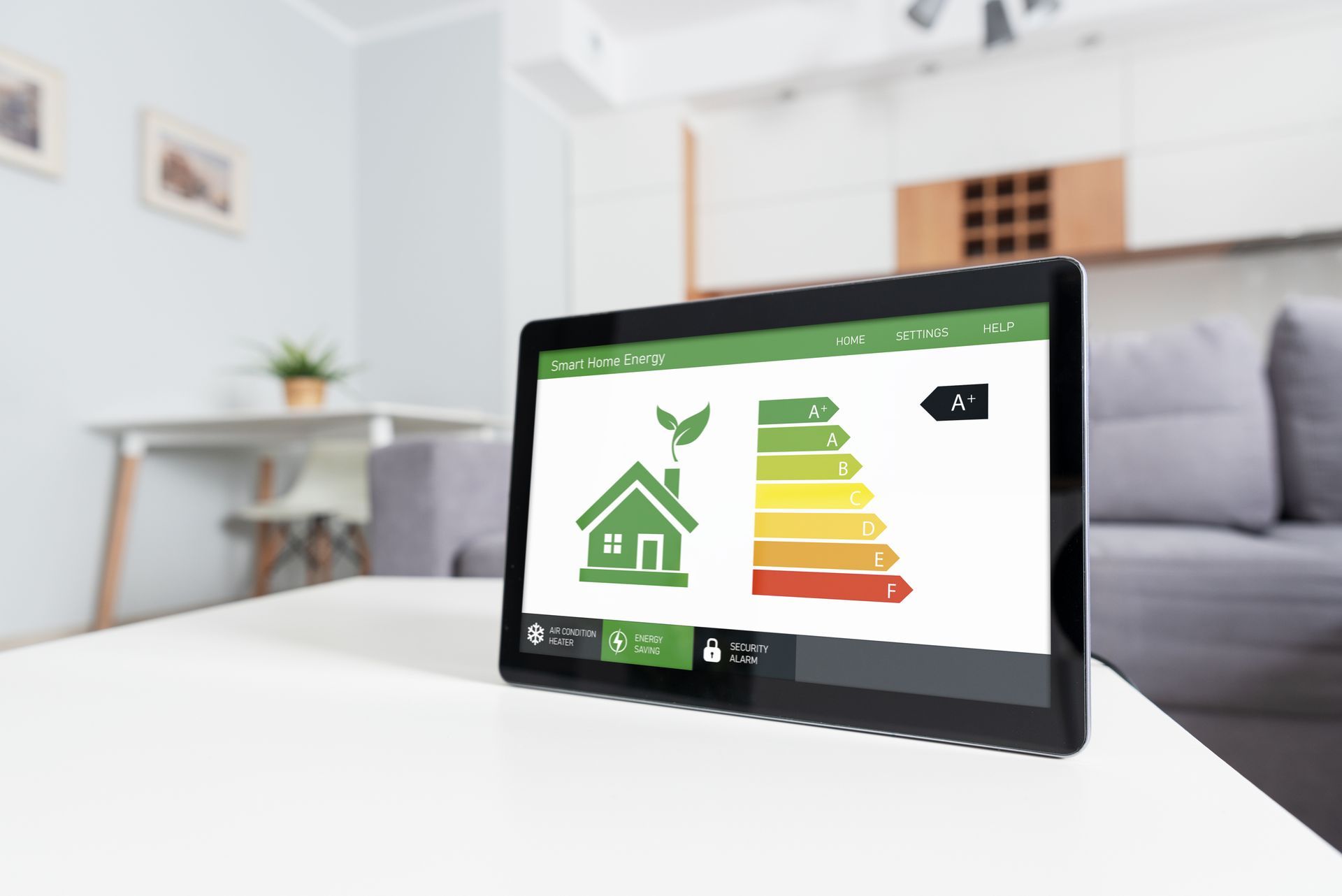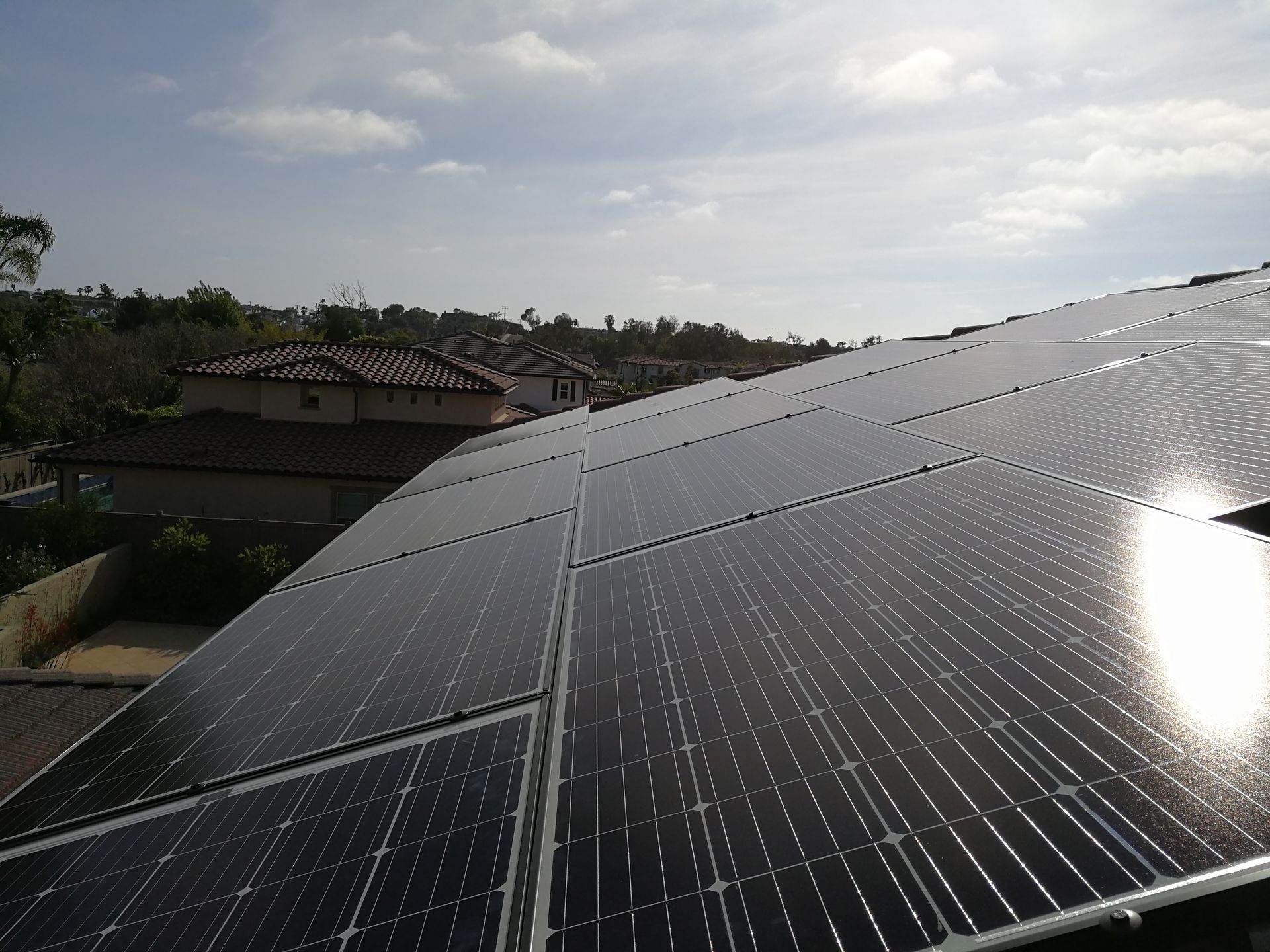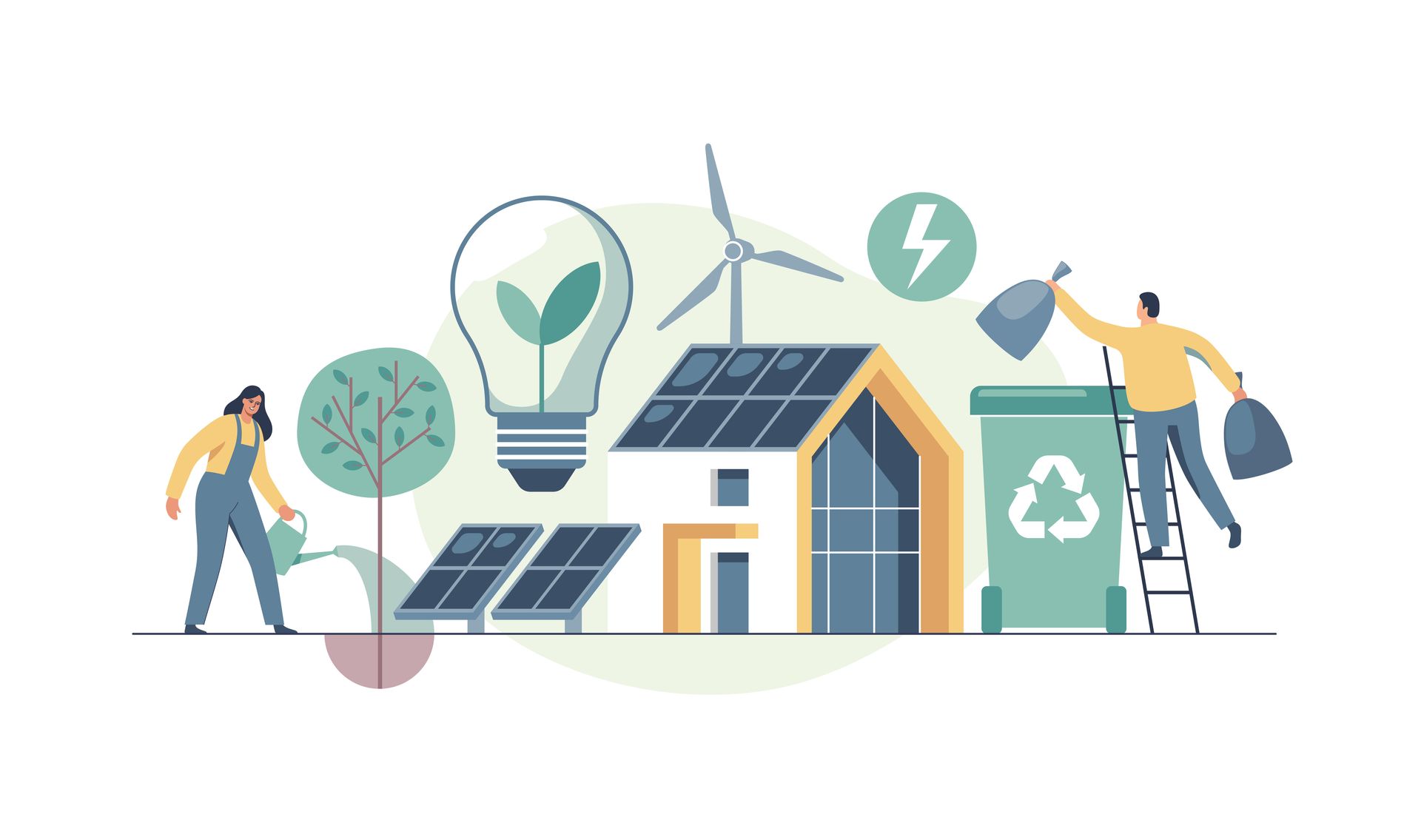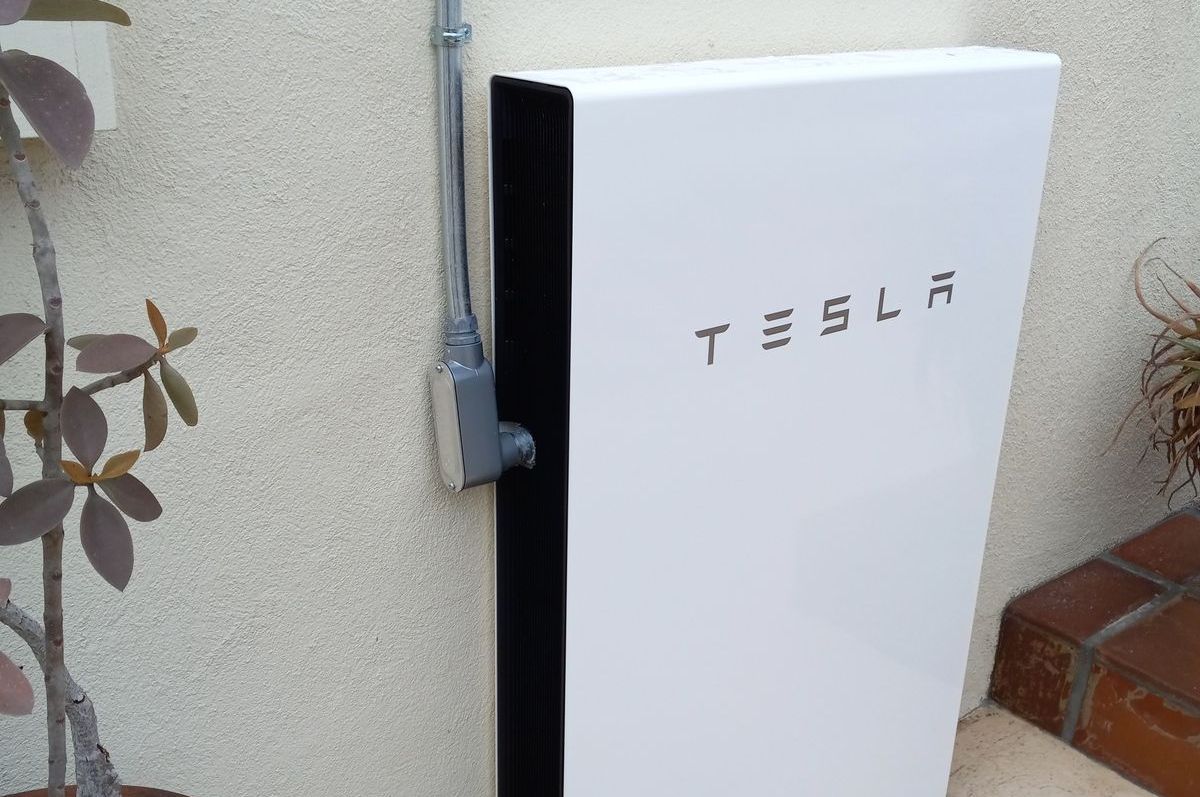News & Blog

In the sunny expanse of Southern California, solar power is more than just a way to reduce utility bills—it’s a significant investment in your property. As environmental awareness increases and technology advances, more homebuyers are recognizing the value of homes equipped with solar energy systems. 1. Increased Property Value: Studies consistently show that homes with solar energy systems sell for more than homes without them. According to a Lawrence Berkeley National Laboratory report, homes with solar panels tend to sell for a premium, with buyers willing to pay additional dollars per watt of installed solar capacity. Premium Pricing: This premium can be particularly significant in Southern California, where sunlight is abundant. The exact increase in home value can vary, but it is generally aligned with the cost of the installed solar system and the savings on energy costs it provides. 2. Attractiveness to Buyers: Solar panels are attractive for home buyers concerned about rising energy costs and environmental impact. Saving on electricity immediately upon purchase is a compelling selling point. Market Trends: In environmentally conscious markets like Southern California, homes with solar installations sell faster than those without. Solar panels are viewed as upgrades, like a renovated kitchen or a new roof, making your property stand out in the competitive real estate market. 3. Energy Independence: Solar power significantly reduces reliance on the grid, providing homeowners with energy security. This can be particularly attractive in areas prone to power outages or high electricity prices. Backup Power: Battery storage systems allow solar panels to provide uninterrupted power during outages, adding further appeal and value to the property. 4. Reduced Carbon Footprint: More buyers are looking for sustainable living options that minimize environmental impact. Solar homes offer this benefit, which aligns with the growing societal push towards sustainability. Green Certification: Homes with solar panels might also qualify for green certification programs, further enhancing their attractiveness to potential buyers who prioritize eco-friendly living. 5. Potential for Future Savings: While the upfront cost of solar installation can be substantial, the long-term savings on energy costs are a huge draw. Homebuyers often consider the return on investment in terms of energy savings when purchasing a solar-equipped home. Incentives and Rebates: Additionally, various federal, state, and local incentives, including tax rebates and credits for solar panel installation, can mitigate the initial installation costs and enhance the investment appeal of solar properties. 6. Considerations for Sellers: If you’re considering selling your home with an existing solar energy system, it’s important to highlight the benefits in your home listing. Be prepared to provide potential buyers with documentation such as: Energy Bills: Show past energy bills to demonstrate the cost savings from solar panels. Maintenance Records: Provide details on the system's upkeep and any warranties that can be transferred to the new owner. Solar panels are a smart investment in Southern California’s robust real estate market. They enhance your home's appeal and market value and contribute to a sustainable future. Whether you're planning to sell your home soon or looking ahead, adding a solar energy system can be a lucrative upgrade that sets your property apart in the bustling Southern California housing market. Ready to Go Solar? If you're considering installing solar panels or want more information about how it can impact your property value, contact a local solar provider today . They can provide a tailored estimate of the costs and benefits, helping you make an informed decision that could significantly enhance your home's value and appeal.

Creating an energy-efficient home is easier than you might think. With a few simple adjustments and DIY projects, you can reduce energy bills, enhance living comfort, and contribute positively to the environment. 1. Optimize Your Insulation: Insulation is a key factor in maintaining your home's temperature. Proper insulation reduces the workload on your heating and cooling systems, making your home more energy-efficient. Attic Insulation: Start by checking the insulation in your attic. This is often the easiest place to add insulation and can significantly reduce heat loss. Weatherstripping: Apply weatherstripping around doors and windows to prevent drafts. This inexpensive, simple measure can greatly enhance your home's thermal efficiency. Window Treatments: To further insulate windows, use thermal curtains. These can block drafts in winter and keep out heat in summer. 2. Upgrade to Energy-Efficient Lighting: Lighting is a crucial aspect of energy consumption in homes. Switching to energy-efficient lighting is a straightforward and cost-effective way to reduce energy usage. LED Bulbs: Replace older incandescent and compact fluorescent bulbs with LED bulbs. LEDs are more energy-efficient and have a longer lifespan. Smart Lighting Solutions: Consider installing smart lights that can be controlled via smartphone apps or home automation systems. These lights can adjust lighting intensity based on the time of day and can be programmed to turn off when not needed. 3. Smart Home Technologies: Smart home technologies not only provide convenience but also help in managing and reducing energy consumption effectively. Smart Thermostats: Install a smart thermostat to better control heating and cooling in your home. These devices learn your schedule and temperature preferences to optimize energy use. Energy Monitors: Use an energy monitor to track your home’s energy consumption in real time. This can help identify high-energy-use appliances and times of day and allow you to adjust accordingly. 4. Maintain Your HVAC System: Your heating, ventilation, and air conditioning (HVAC) system significantly affect your home’s energy consumption. Regular maintenance can help ensure it operates efficiently. Regular Filter Changes: To keep your system running efficiently, change or clean your HVAC filters every 1-3 months. Annual Servicing: Have your HVAC system serviced by a professional at least once a year to maintain its efficiency and prolong its life. Seal Ducts: Check your ductwork for leaks or gaps. Sealing these can improve the efficiency of your heating and cooling system by up to 20%. 5. Water Heating Efficiency: Water heating is a major contributor to energy expenditure in the home. Making it more efficient can lead to significant savings. Low-Flow Fixtures: To reduce hot water use, install low-flow showerheads and faucet aerators. Insulate Water Heater: Wrap your water heater and its pipes in an insulating blanket to prevent heat loss, improve efficiency, and reduce costs. Improving your home’s energy efficiency doesn’t have to be a daunting task. By implementing these practical DIY tips and embracing smart technologies, you can significantly lower your energy bills while increasing your home's comfort and value. Every step you take contributes to a more sustainable lifestyle and enhances the overall functionality of your living space. Start with small changes and gradually work your way to incorporate more complex energy-saving measures. Your wallet—and the planet—will thank you!

Improving your home's energy efficiency is smart—it can reduce your energy bills, increase your property value, and lessen your environmental impact. Many energy-saving changes are straightforward and can be done yourself. In this blog post, we'll explore practical DIY tips for enhancing energy efficiency across your home and discuss when it might be time to call a professional. 1. Seal and Insulate Your Home: Proper insulation and sealing can significantly reduce heating and cooling costs by keeping your home's temperature constant. Windows and Doors: Check for drafts around windows and doors. Seal any gaps with weather stripping or caulking. Insulation: Enhance insulation in key areas such as the attic, walls, and floors. Insulation materials like fiberglass, foam board, or cellulose can be handled as DIY projects, but be sure to wear protective gear. 2. Upgrade to Energy-Efficient Lighting: Switching to energy-efficient lighting is one of the easiest and most cost-effective ways to cut energy usage. LED Bulbs: Replace incandescent bulbs with LED bulbs, which use at least 75% less energy and last 25 times longer. Smart Lighting Controls: Consider installing dimmers, timers, or smart light switches that automatically turn lights off when unnecessary. 3. Install Smart Home Technologies: Smart home devices not only enhance convenience but also help in saving energy. Smart Thermostats: These devices adjust your heating and cooling based on your schedule and preferences, and can be controlled remotely through your smartphone. Energy Monitors: Use an energy monitor to track how much electricity your home uses and identify appliances or devices that consume the most power. 4. Use Energy-Efficient Appliances: Appliances account for a significant portion of your energy consumption. Energy Star Appliances: When replacing old appliances, choose Energy Star-certified products that meet energy efficiency guidelines set by the U.S. Environmental Protection Agency. Maintenance: Keep appliances clean and in good working order. For example, regularly clean or replace filters in your HVAC system and ensure the refrigerator door seals tightly. 5. Water Conservation: Reducing water use can also lower your energy bills, particularly if you have an electric water heater. Low-Flow Fixtures: Install low-flow showerheads and faucets to reduce hot water use without sacrificing performance. Water Heater Insulation: To prevent heat loss, insulate your water heater and the first six feet of hot and cold water pipes. When to Call a Professional: While many energy efficiency upgrades are suitable for DIY, there are times when hiring a professional is advisable: Complex Installations: Projects like installing solar panels or upgrading your electrical panel should be handled by licensed professionals to ensure safety and compliance with local building codes. HVAC Maintenance: Annual servicing of your heating and cooling system can extend its life and maintain efficiency, but a certified technician should do this. Insulation Upgrades: If you're considering spray foam insulation or are unsure of the correct type or amount of insulation needed, a professional assessment can be very beneficial. Electrical Work: Any project that involves major electrical changes should be done by a qualified electrician to avoid the risk of fire or injury. Improving your home's energy efficiency doesn't just contribute to a healthier environment—it also boosts your home’s comfort and lowers your energy bills. Many effective upgrades can be achieved through DIY projects, but it’s important to recognize when a professional is needed to ensure the job is done safely and effectively. Need Professional Help? If you need help tackling an energy efficiency project on your own, or if you need more complex upgrades, consider contacting a local energy efficiency expert. Professional advice can help you make the most informed and safe choices for your home improvement projects.

As solar energy becomes increasingly popular, more people are curious about how it works and whether it's the right choice for their homes. This beginner's guide will demystify solar energy, explaining how solar panels work, the installation process, and the benefits of switching to solar power. 1. How Solar Panels Work: Solar panels comprise many solar cells at the core of solar technology. These cells are usually made from silicon, which has a property that allows it to absorb sunlight and convert it into electricity. Here’s a simplified breakdown of the process: Sunlight hits the solar panel: Solar cells absorb sunlight, and each cell creates an electric field that causes electricity to flow. The conversion of sunlight to electricity: The process of converting light (photons) to electricity (voltage) is called the photovoltaic effect. From DC to AC: Solar panels generate direct current (DC) electricity. However, most homes and appliances use alternating current (AC), so the DC electricity is passed through an inverter to convert it to usable AC electricity. Powering Your Home: Once converted to AC, the electricity routes to your home’s electrical panel and is distributed to power lights, appliances, and other devices. 2. The Installation Process: Installing solar panels involves several key steps: Initial Consultation: Typically, the process begins with a consultation, where a solar provider assesses your home’s viability for solar, considering factors like roof space, orientation, and shading. Design and Engineering: Once you decide to proceed, engineers design a solar system tailored to your home's specifications and energy needs. Permits and Paperwork: Solar installations require various permits and paperwork, which your solar provider will handle. These may include local building permits and applications for available incentives or rebates. Installation: The actual installation is often completed in a few days. It includes mounting the solar panels on your roof and installing the inverter and other necessary equipment. Inspection and Connection: A local government or utility representative will inspect the system after installation. Once it passes inspection, it’s connected to the grid, and you’re set to start generating solar power. 3. Benefits of Switching to Solar Power: Switching to solar power offers numerous benefits: Reduced Electricity Bills: Solar power can significantly reduce or even eliminate your monthly electricity bills, as you’ll generate your own energy. Increase in Property Value: Homes with solar energy systems often see an increase in property value, making it a wise investment. Environmental Impact: Solar energy is clean and renewable, reducing your carbon footprint and contributing to a reduction in greenhouse gas emissions. Energy Independence: By generating energy, you reduce dependence on traditional power sources and protect yourself against energy price volatility. Incentives and Rebates: Many governments offer incentives, rebates, or tax breaks to offset the initial costs of solar panel installations. Solar energy is a powerful, sustainable, and increasingly cost-effective option for powering your home. By understanding how solar panels work, the installation process, and the benefits they offer, you can decide whether solar power is right for you. With its numerous advantages, solar energy is more than just a trend; it's a long-term solution for reducing energy costs and promoting a healthier environment. Ready to Explore Solar Solutions? If you’re considering solar power for your home, contact Asgard Energy today. Our team of experts is ready to guide you every step of the way, from initial consultation to final installation, ensuring you get the most out of your solar investment. Let us help you harness the sun's power and enjoy cleaner, more sustainable energy.

As global awareness of environmental issues grows, more homeowners are turning to renewable energy sources to reduce their impact on the planet. Solar energy, one of the most accessible and effective renewable energy sources, offers significant environmental benefits that are particularly appealing to eco-conscious individuals. This blog post explores how adopting solar energy can help reduce your carbon footprint, decrease greenhouse gas emissions, and contribute to a sustainable future. Reducing Carbon Footprint: One of solar energy's most compelling environmental benefits is its ability to reduce your carbon footprint significantly. Unlike traditional fossil fuels, solar panels generate electricity without burning any fuel or releasing carbon dioxide (CO2) into the atmosphere. Impact on Carbon Reduction: The average residential solar panel system can reduce carbon emissions by approximately three to four tons annually. Over the system's lifetime, this adds up to a substantial reduction in your household's overall carbon emissions. Decreasing Reliance on Fossil Fuels: By choosing solar energy, homeowners can reduce their reliance on fossil fuels, the primary source of global greenhouse gas emissions. This shift helps mitigate climate change and reduces air pollution, promoting cleaner air and a healthier environment. Broader Impacts: Beyond individual reductions, widespread adoption of solar energy can lessen national dependence on imported fuels, enhancing energy security and stability. Conserving Water Resources: Solar energy systems also contribute to water conservation, an important aspect in regions facing water scarcity issues. Traditional power production, particularly thermoelectric power, is a major consumer of water used to cool generators and process fuel. Water Conservation: Solar photovoltaic cells do not require water to generate electricity, making them an ideal alternative in arid regions or places where water conservation is critical. Supporting Biodiversity: Solar farms, especially when properly planned to avoid sensitive areas, can impact biodiversity less than conventional energy sources. They can be developed on degraded lands and potentially coexist with agricultural uses, promoting a more balanced and sustainable land use strategy. Dual Use of Land: Some innovative solar installations include “agrivoltaics,” where solar panels and agriculture coexist, enhancing land productivity while generating energy. Encouraging Technological Advancement and Sustainable Practices: The solar industry's growth drives technological innovation, leading to more efficient and environmentally friendly solar solutions. Furthermore, the industry prioritizes sustainability in manufacturing and recycling old solar panels, reducing waste and environmental impact. Lifecycle Management: As the industry matures, recycling processes and programs are expanding, ensuring that solar panels continue to benefit the environment even after their usable life. Creating a Sustainable Community: Adopting solar energy not only benefits the individual homeowner but also contributes to the creation of sustainable communities. It supports local jobs in the green economy, reduces overall community emissions, and sets a precedent for future development projects to incorporate sustainable energy solutions. Conclusion Solar energy represents more than just savings on energy bills; it's a step towards a cleaner, more sustainable way of living. By reducing carbon emissions, conserving water, and promoting biodiversity, solar energy helps protect our planet for future generations. For eco-conscious homeowners, switching to solar is a direct action towards reducing environmental impact and promoting a sustainable future. Thinking About Solar? If you're ready to impact the environment and explore solar energy solutions positively, Asgard Energy is here to help. Our team is dedicated to providing you with the most efficient and environmentally friendly solar installations. Contact us today to learn more about how you can contribute to a greener tomorrow.

Switching to solar energy is an environmentally conscious decision and a financially savvy one, especially in Southern California. Thanks to various federal and state incentives, tax breaks, and rebates, installing solar panels has become increasingly affordable for homeowners and businesses. In this blog post, we'll navigate the landscape of these financial incentives and explain how you can take advantage of them to reduce the cost of your solar energy system. Federal Solar Investment Tax Credit (ITC): One of the most significant incentives for solar panel installation is the Federal Solar Investment Tax Credit (ITC). This credit allows you to deduct a portion of the cost of installing a solar energy system from your federal taxes. How It Works: Currently, the ITC offers a 26% tax credit for systems installed by the end of 2022. This percentage will drop to 22% in 2023, and by 2024, residential solar installations will no longer qualify for the ITC, though commercial systems will still receive a 10% credit. Eligibility: The ITC is available to residential and commercial U.S. customers who install solar PV systems. California Solar Initiative (CSI): The California Solar Initiative is another program offering solar installation rebates on homes and businesses. While the general market program has reached its capacity and no longer accepts new applications, some specific program segments remain active. CSI-Thermal program: Offers rebates for solar water heating systems, including those for single-family and multifamily homes, as well as commercial, industrial, and agricultural properties. Self-Generation Incentive Program (SGIP): For those interested in adding energy storage to their solar system, the SGIP can be particularly beneficial. This program provides rebates for installing energy storage systems, which can enhance the usability and efficiency of your solar power setup. Benefits: Energy storage allows you to store excess solar energy instead of returning it to the grid. This energy can be used during power outages, peak energy usage times, or at night, further reducing your electricity bills and increasing energy independence. Net Energy Metering (NEM): Net Energy Metering (NEM) is another crucial incentive for California solar users. Solar energy system owners can receive financial credit for surplus energy produced and fed back into the grid. How It Works: If your system produces more electricity than you need, the excess energy returns to the grid, and you receive a credit on your electric bill. Recent Changes: Be aware that NEM policies are subject to change and vary by utility company. It’s essential to consult with your local utility company or a solar professional to understand the current terms and how they might impact your decision to go solar. Local Incentives and Rebates: Various local utilities and governments in Southern California also offer incentives. These can vary widely depending on your location, so it's worth researching what's available in your area. Examples include: Los Angeles Department of Water and Power (LADWP) Solar Incentive Program: Offers a per-watt rebate for solar installations. San Diego Solar Program: Provides financial incentives based on the size of the solar system installed. Conclusion: The combination of federal, state, and local incentives makes installing solar panels in Southern California an attractive investment. By reducing initial costs and providing ongoing benefits, these incentives make solar energy more accessible and financially beneficial. Ready to Explore Solar Options? If you're considering taking advantage of these incentives and installing a solar system, Asgard Energy is here to help. Our team can guide you through the process, ensuring you maximize all available financial benefits. Contact us today to start your journey towards sustainable and cost-effective solar energy.

Investing in solar panels is a significant step toward sustainability and energy independence. Regular maintenance ensures you get the most out of this investment. Proper upkeep extends the lifespan of your solar panels and maximizes their efficiency and performance. In this blog post, we'll explore practical tips for maintaining your solar panels and discuss what you can expect regarding their longevity. 1. Understanding Solar Panel Longevity: Solar panels are designed to be durable and withstand the elements, typically lasting 25 to 30 years or more. However, their lifespan can be significantly influenced by the environment and the level of maintenance they receive. While solar panels generally require minimal upkeep, but a few key practices can help ensure they perform optimally throughout their lifespan. 2. Regular Cleaning: Dust, pollen, leaves, and bird droppings can obstruct sunlight and reduce the efficiency of your solar panels. Here’s how you can keep them clean: Frequency of Cleaning: The cleaning frequency depends on your location. If you live in a dusty area or have heavy foliage overhead, you might need to clean your panels more often. Methods of Cleaning: For most homeowners, cleaning solar panels with a garden hose from the ground is sufficient. If more thorough cleaning is needed, using a soft brush or a squeegee attached to a long pole can help remove stubborn grime. Ensure you use soapy water or a cleaning solution designed for solar panels to avoid damaging the surface. 3. Professional Inspections: While basic cleaning can be done independently, regular professional inspections should be scheduled. A solar technician can: Check for Physical Damage: Inspecting panels for cracks, scratches, or other signs of wear that could affect performance. Verify Connections: Ensuring all electrical connections are secure and intact to prevent power losses. Update Systems: Technicians can also update firmware and ensure that all solar system components are functioning correctly. 4. Monitoring Performance: Most modern solar systems have monitoring technology that allows you to track their performance. Regular monitoring can help quickly identify issues such as: Unexpected Power Drops: Sudden decreases in power output can indicate a problem with one or more panels. Inconsistencies in Production: Variances in power generation between similar conditions can suggest issues needing closer inspection. 5. Preventative Measures: Taking preventive measures can also go a long way in maintaining the performance and longevity of your solar panels: Trim Overhanging Branches: Prevent leaves and debris from accumulating on the panels. Install Pest Guards: Keep birds and squirrels from nesting under the panels, which can cause damage over time. Regularly Check for Shade: As trees grow or new buildings are constructed, they might cast shade on your panels, necessitating adjustments to their placement. 6. Handling Repairs and Warranties: If a problem requires more than basic maintenance, consulting with professionals rather than attempting DIY repairs is important, which can void warranties. Most solar panels come with long-term warranties that cover performance and equipment. Understanding your warranty coverage can help manage repair costs effectively. Conclusion: Maintaining your solar panels is not just about cleaning and inspections; it's about ensuring that your investment continues to pay dividends in terms of energy savings and environmental impact for many years. By adopting a proactive approach to solar panel maintenance, you can secure their efficiency and longevity, making solar power a reliable part of your home's energy solution. Need Expert Solar Maintenance? If you're looking for professional solar panel maintenance or need advice on extending the lifespan of your solar setup, Asgard Energy is here to help. Our experienced technicians are equipped to provide comprehensive care for your solar panels, ensuring they operate at peak efficiency. Contact us today to schedule a maintenance check-up and continue enjoying the benefits of solar energy without interruption.

Southern California is known for its sunny days and mild climate, making it an ideal location for harnessing solar energy. However, like any region, it's not immune to extreme weather conditions, including heat waves and occasional heavy rains. Homeowners and businesses considering solar power often express concerns about how well solar panels can perform under such conditions. In this post, we'll explore the resilience of solar panels during Southern California's weather extremes and dispel some common worries. Solar Panels in Heat Waves One might assume that more heat equals more power from solar panels, but that's not entirely the case. Solar panels operate most efficiently in cool, sunny conditions. High temperatures can reduce their efficiency, but the impact is often less significant than many fear. Modern solar panels are designed to withstand high temperatures, and the decrease in efficiency is typically factored into the system's overall design. In Southern California, where heat waves are common, solar panels are installed with these conditions in mind, ensuring they continue to provide substantial energy output even on the hottest days. Performance During Heavy Rains Rain is often seen as a deterrent to solar energy production. However, occasional heavy rains can benefit solar panels by helping clean them, and removing dust and other accumulations that can reduce efficiency. While it's true that solar panels generate less power on cloudy or rainy days, they don't stop producing electricity altogether. The key is the overall energy production across a year. Southern California's abundant sunny days more than compensate for reduced output during less sunny periods, ensuring reliable solar energy production year-round. Durability Against Extreme Weather Concerns about the durability of solar panels during extreme weather events are common. It's important to know that solar panels are rigorously tested to withstand harsh conditions, including heavy winds and rains. Most panels are rated to endure wind speeds up to 140 miles per hour and can withstand the impact of falling debris and hail. Manufacturers and installers in Southern California consider local weather patterns, ensuring that solar installations are efficient and durable. Maximizing Solar Panel Efficiency and Longevity Proper installation and maintenance are key to maximizing the efficiency and longevity of solar panels in extreme weather. This includes: Choosing the right location: Ensuring panels are installed optimally for sun exposure while considering potential shade and debris accumulation. Regular maintenance: Periodic checks and cleaning to keep panels operating at peak efficiency. Monitoring performance: Using solar monitoring systems to track energy production and promptly identify issues. Embracing Solar Power with Confidence Understanding the resilience of solar panels against Southern California's extreme weather conditions allows homeowners and businesses to embrace solar power with confidence. The technology behind solar panels has advanced significantly, ensuring they can withstand and perform under the region's diverse weather patterns. Conclusion The performance of solar panels during extreme weather conditions is a valid concern for anyone considering solar power. However, with technological advancements and proper planning, solar energy remains a reliable and efficient power source for Southern California residents, even in the face of heat waves or heavy rains. By addressing these concerns head-on, we can continue to move towards a sustainable and resilient energy future. Contact Asgard Energy Are you ready to harness the power of the sun? Contact Asgard Energy , your trusted provider of high-quality solar solutions in Southern California. Our team is dedicated to helping you navigate the solar energy process, from choosing the right system to ensuring it's optimized for all weather conditions.

The sun is a powerful renewable energy source, and with the advent of solar technology, we've found ways to harness this energy to power our homes and businesses. However, the challenge has always been: What happens when the sun isn't shining? This is where solar energy storage solutions come into play, ensuring that the clean, renewable energy you generate doesn't go to waste. The Role of Solar Batteries in Energy Storage: Solar batteries are at the heart of solar energy storage. They store the excess energy generated by your solar panels during sunny periods. This stored energy can be used at night or during power outages, making your home or business more resilient and energy-independent. The technology behind solar batteries has advanced significantly, offering higher capacities and longer life spans. Types of Solar Batteries: There are several types of solar batteries available, each with its unique features: Lead-Acid Batteries: These are the traditional batteries used in solar setups. They are more cost-effective but have a shorter lifespan and lower energy density. Lithium-Ion Batteries: These are more modern, have a higher energy density, longer lifespan, and require less maintenance than lead-acid batteries. They're more expensive upfront but offer better long-term value. Flow Batteries: A newer technology, flow batteries, offer a longer lifecycle and are ideal for large-scale energy storage. How Solar Batteries Enhance Energy Independence: With solar batteries, you're not just generating clean energy but also ensuring that this energy is available when you need it most. During power outages, your stored solar energy can be a lifeline, powering essential appliances and keeping your home operational. Solar Batteries and Grid Services: In addition to providing backup power, solar batteries can also offer grid services. When connected to the grid, your battery can supply excess energy, potentially earning you credits on your utility bill. This process, known as net metering, benefits you and contributes to the stability and sustainability of the local power grid. Choosing the Right Solar Battery for Your Needs: Selecting the correct solar battery depends on several factors, including your energy needs, budget, and solar panel system size. It's essential to consult with a solar energy expert to determine the best fit for your specific situation. Conclusion: Solar energy storage solutions, particularly solar batteries, are transforming how we think about and use renewable energy. By storing excess solar energy, these systems ensure the power you need is available when the sun isn't shining, providing peace of mind and energy security. As solar technology continues to evolve, we can expect even more efficient and cost-effective storage solutions, further empowering homeowners and businesses to embrace the full potential of solar energy. Contact Asgard Energy: Are you interested in learning more about solar energy storage solutions for your home or business? Contact Asgard Energy , Southern California's leading high-quality solar and electrical services provider. Our team of experts is here to guide you through choosing and installing the perfect solar energy storage system to meet your needs.

